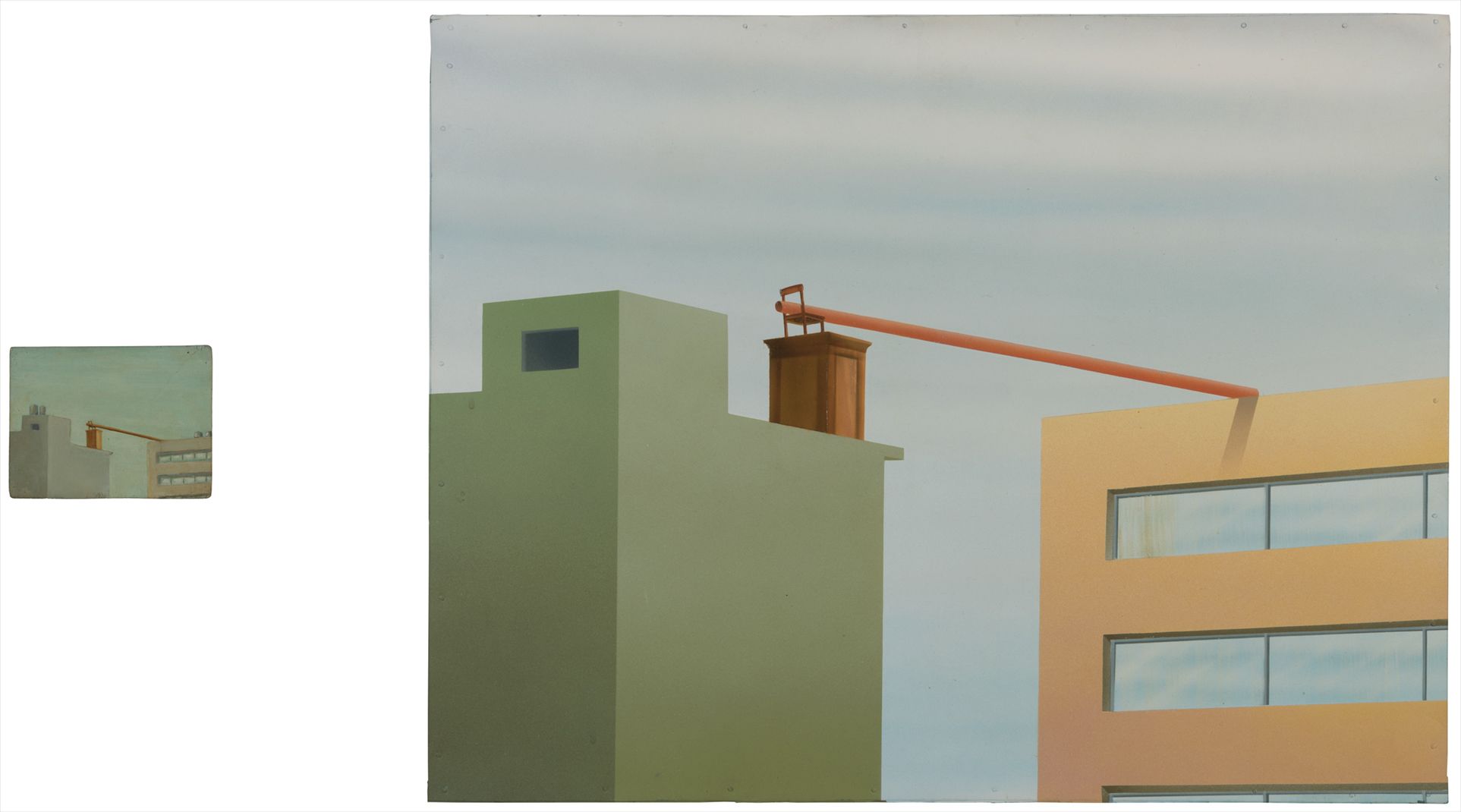

32
Francis Alÿs
Emilio Rivera
ii) enamel on metal sheet mounted on wood
ii) 21 1/4 x 27 7/8 in. (54 x 70.8 cm)
Full-Cataloguing
Francis de Smedt arrived in Mexico City during the mid-1980s to work as part of an aid project in the State of Oaxaca to escape the draft in Belgium. This led to his permanent residence in Mexico, and in order to avoid any confict with the Belgian authorities, he created his pseudonym, Francis Alÿs. In this sense, the allure of Mexico for him had nothing to do with the reasons other foreign artists and intellectuals traditionally were drawn to Mexico. While living in Mexico City and given his background in architecture, Alÿs became intrigued by a certain urban texture that the megalopolis ofered. Alÿs literally began walking through Mexico City in an attempt to explore and find a physical space. He immersed himself in an unknown territory as a foreigner and used his foreignness as a form of integration with that urban space, eventually leading to his public interventions. One of his frst artistic works was Turista, 1994, which provided the foundation for his body of work and gave the art world an insight into the caliber of his art. In this intervention he photographed himself against the railings of the cathedral in the Zócalo, a place where plumbers, electricians and other tradesmen publicize themselves for business purposes with hand painted signs indicating their trade. Alÿs also placed a hand-painted sign indicating his trade as a turista (tourist). This intervention epitomized the degree to which his own walks and explorations as a tourist had become a way of life. Furthermore, his poetic wanderings became associated with the contemplative walks of the flâneur.
During this period, Alÿs noticed the widespread use of hand-painted signs that advertised anything from massive political propaganda, to small advertisements identifying stores and workshops. Unlike their role in the industrial world, sign painters in Mexican society still play a significant role in society, as for example their political signage used at official rallies. This made Alÿs realize that the language and medium of these sign painters provide us with a language that is still an essential means of social communication. This led Alÿs to start a large project working with rotulistas in different series. The rotulistas made Alÿs realize that he wanted to communicate to a wider audience through his paintings. Thus, impressed by the power of communication the rotulistas possessed, he started borrowing some of their iconography, but this did not satisfy him. Then he asked rotulistas to realize a different version of one of his scene paintings, respecting
the basic image but “improving” it as much as they wanted, to achieve the clarity he was after. Thus, his larger project with these rotulistas alludes to the Duchampian question: Can one make works of art that are not works of art? He also borrows Nicolas Bourriaud’s process of postproduction which is a process of reappropriating the work of artisans and vice-versa. This procedure is important, as “[it] goes beyond the distinctions between creating and copying, production and consumption” (T. Vischer, Francis Alÿs—Sign Painting Project with Juan García, Emilio Rivera, Enrique Huerta, Switzerland, 2011, p. 20).
One of the series in this project is Cityscapes, to which the present lot belongs, where the paintings depict enigmatic façades and arrangements of buildings, along with billboards, staircases, planks, cupboards and other similar objects. While most of the paintings depict human figures, this series is rare as only about 20 sets were created and each work features furniture as the central figure instead, performing balancing acts and bridging gaps between buildings. In Emilio Rivera, 1994, there are two modern buildings whose balconies are connected by a long red pole that rests on a chair in the lower building, which also rests on a wooden piece of furniture. On a formal level, this is an alluring representation of a modern city and illustrates the poetics of an architectural still life. Although seemingly light-hearted and contemplative, the glitches and gravity-defying furniture are elegantly integrated with the cityscapes, which demand of the viewers closer observation and make us realize that they toy with our perceptual reason. Alÿs was inspired by Italian artists such as Fran Angelico, particularly in the little paintings he did for the base of church altars that depicted microscopic anecdotes of urban living. The smaller painting accompanying this work can also be seen as a microscopic cityscape reminiscent to those works. In short, these unassuming paintings convey the diverse pictorial approaches personified by Alÿs and his group of sign painters. They not only illustrate the complex relationship between art, craft and collaboration, they also bridge the divide between crafts and fine art through their unique concern with communicating the wealth of visual pleasure to be found in the modern urban landscape and people who inhabit it.
Francis Alÿs
Belgian / Mexican | 1959Born in Belgium, Francis Alÿs traveled to Mexico in 1986 as part of a French program to assist in the aftermath of the tragic 1985 earthquake, and has lived there ever since. Throughout his career, the artist has analyzed facets of everyday urban life using a variety of media including video, drawing, installation and public action. Sign Painting Project (1993-'97) is a prime example of the artist's interest in the sprawling urbanization of Mexico City. In this early series, Alÿs drew inspiration from professional Mexican sign painters (rotúlistas) who painted large billboard advertisements throughout the city. In response to these large colorful compositions, Alÿs employed a similar style in creating small-scale paintings of familiar objects and places. Alÿs asked various rotúlistas to copy and enlarge his paintings, displaying his work and that of the rotúlista side-by-side. This series, like many of Alÿs' other works, illustrates the artist's concerns with such themes as collaboration, banality and originality.